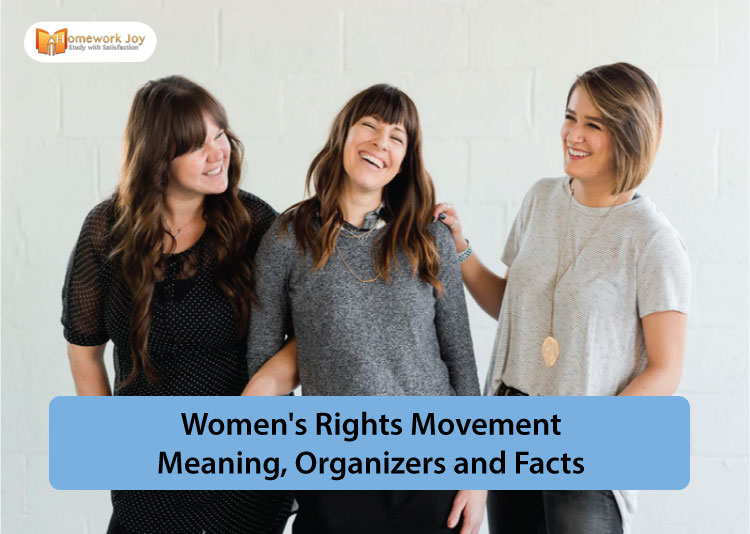The women’s rights movement or women’s liberation movement is a diverse social movement. It is largely a social movement in the United States, seeking equal rights and women opportunities. Moreover, it coincided with the “second wave” of feminism. On the contrary, first-wave feminism focused on women’s legal rights, especially the right to vote in the 19th and early 20th centuries.
The second wave of the women’s rights movement touched on every area of women’s life, namely, politics, work, the family, and sexuality. Women’s activism continued throughout the mid-1990s and the early 2010s, respectively. It took around 100 years for the activist to win the rights of women.
Beginning of the Women’s Rights Movement
The campaign for the women’s rights movement began in the decades before the Civil War took place. During the 1820s and 30s, states had extended the franchise to all white men across the country irrespective of their possessions.
Furthermore, all sorts of reform groups were increasing across the United States. Some of them were religious movements, moral-reform societies, and so on, wherein most of them, women played a prominent role.
Meanwhile, many American women were angry over the duties assigned to a certain gender. The women were against the idea that a “true” woman was a pious and submissive wife and mother whose only duty is to look after the family and serve them.
To sum up, all of these factors ignited a flame of a new way of thinking and bringing a change in women’s position in society, the United States.
Seneca Falls Convention
The Seneca was the first convention for the women’s rights movement in the United States. It is originally known as the Woman’s Rights Convention, and it fought for the social, political, and religious rights of women. The convention meeting was held in 1848 at the Wesleyan Chapel in Seneca Falls, New York. Despite the negligible publicity, most of the area residents showed up.
The discussion in the convention was around the 11 resolutions on women’s rights. All the resolutions passed except for the resolution, which demanded the right to vote for women. Stanton and African American abolitionist Frederick Douglass gave powerful speeches in its defense before it eventually passed.
Women’s Rights Movement- Seneca Falls Convention Organizers
The women organizers of the Seneca Falls also played an active part in the abolitionist movement, which included an end to slavery and racial discrimination. The organizers of the women’s rights movement are:
1. Elizabeth Cady Stanton
She was an active women’s rights advocate who was a driving organizer of the Seneca Falls Convention. Stanton became more invested in women’s rights after a discussion with her father, a law professor. Moreover, she started working on women’s property rights reform in the early 1840s.
2. Lucretia Mott
Lucretia was known for her anti-slavery, women’s rights, and religious reform activism.
3. Martha Coffin Wright, Lucretia Mott’s sister
Lucretia Mott’s sister is Martha. In addition to being a lifelong proponent of women’s rights, she was an abolitionist who ran a station on the Underground Railroad, New York.
Interesting Facts about Women’s Rights Movement
Let’s see some of the interesting facts of the women’s suffrage movement.
1. The US Women’s Rights Movement had its Roots in the Abolition Movement
Anti-Slavery Society, led by William Lloyd Garrison, provided women opportunities to speak, write, organize, and leadership roles. Prominent women abolitionists included the sister’s Angelica and Sarah Grimké, Harriet Beecher Stowe, and the former slave Sojourner, whose “Ain’t I a Woman?” speech earned her lasting fame.
2. After the Civil War, Women’s Rights Activists Parted Ways Over Women’s Suffrage
The plan of the women’s rights movement included much more than just the right to vote. The broad plan included access to education and employment, equality within marriage, and control over her own body.
The grant of citizenship and voting to African-American men inspired many women’s rights activists to focus their efforts on the battle for female suffrage. Some prominent female figures, like Stanton and Susan B. Anthony campaigned against the amendments that would exclude women.
3. Susan B. Anthony Illegally Voted in Presidential Elections
Susan B. Anthony led a group demanding to vote in Rochester, New York. All females were arrested, but only Anthony was tried for violating the 14th Amendment, which guaranteed “the right to vote to all the male inhabitants”.
4. The Women’s Movement Paved a way to Set Fashion Trends
The early fashion rebellion helped to highlight their movement. Elizabeth Smith Miller of Geneva debuted a radical new look: a knee-length skirt with Turkish-style pantaloons gathered at the ankle. She urged other women to shed their heavy, bulky hoop skirts and have their own style.
Conclusion
Eventually, some states in the West began to extend the vote to women for the first time in almost 20 years. Still, southern and eastern states refuted. Meanwhile, National Woman’s Party founder Alice Paul focused on militant tactics like hunger strikes. It was basically to publicize the issue and gain rights. Women’s In World War I, women’s work proved that they were just as patriotic and deserving of citizenship as men.
Finally, in August 1920, the 19th Amendment to the Constitution was approved. Hence, on 2 November 1920, more than 8 million women across the United States voted in elections for the first time.
